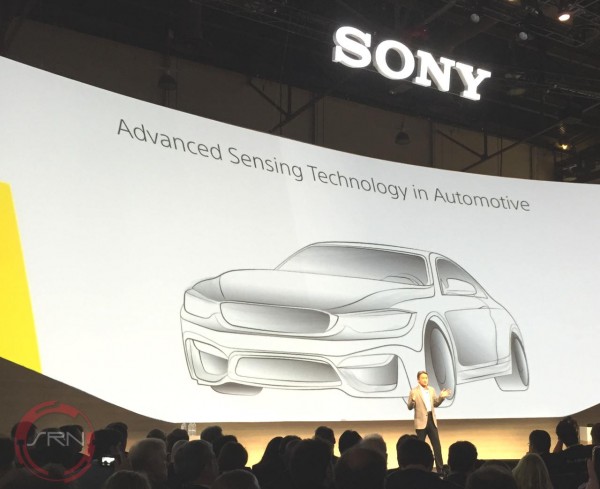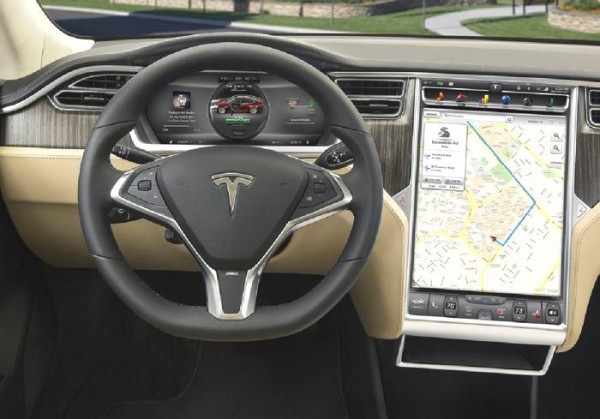
Google hasn’t made it a secret that they have ambitions for the car. While it remains unclear what exactly Google will do with their car projects, the search giant has already shown off their self-driving vehicles on more than one occasion. On the other end of the spectrum, while mum is the word from the Cupertino-based company, a lot of speculation has pointed towards Apple also swarming around the car sector with high profile meetings at BMW and higher from Tesla and Mercedes-Benz. Even if no cars come from the two tech giants, the car market is already set to change thanks to their involvement with improving the in-dash experience via CarPlay and Android Auto.
Now comes word that Sony, another electronic company who’s no stranger to cars, might also be entertaining the idea of building their own vehicle. So meet me after the jump to discuss the possibilities of a Sony car.
History
While a far cry from making a car, Sony has had a long and rich history of working with automotive companies. With their line of Xplod speakers, amps, and receivers (now simply called Sony), the car dash has seen different iterations of navigation systems and CD players from Sony over the years. Not limiting themselves to just aftermarket installs, Sony in the last few years has signed a contract with Ford. According to the Detroit automaker,
exclusive Sony audio system with two industry-first technologies – Live Acoustics and Clear Phase
are the center of the most recent Ford vehicles which in short are designed to give you better sound.
Motorola Rokr is to iPhone as CarPlay is to Apple Car?
Launched in September of 2005, the Motorola Rokr was born from a partnership with Apple. Emphasizing 100 songs in your pocket, the Rokr was the first phone of its kind that could connect to iTunes and easily transfer your music. Until the Rokr came to be, most phones were either tied to abysmal “storefronts” from carriers which offered only a handful of artists to download music from – or owners were limited to finding third party apps in order to transfer their music. Two years after the Rokr, Steve Jobs famously took to the stage to announce three products:
An iPod, a phone, and an internet communicator
Of course, that device turned out to be the iPhone and the rest as they say is history. The funny thing about history is that it tends to repeat itself more often than we’d either care to admit or are aware of. The center dash for the car has always been between functional and terrible. This experience’s degradation has only been expedited with the advent of the iPhone, which has changed how we perceive UI and hardware. Navigation systems on modern cars are still cumbersome for entering in destinations. Multitouch is either not a thing or terribly laggy and UI, more often than not, simply makes no sense.
Then there is the simple little fact that our car dash systems have little to do with our lives. Our reminders and calendars don’t populate them. There is no personal Siri-like assistant that can help us with texts, upcoming events, and restaurant recommendations. Streaming music services are limited and there’s simply no access to a expanding and healthy app store. Our cars make a great example of the divide between analogue and digital.
Apple seems to agree with the general consensus that the dash experience in most of cars suck. To that end, they’ve been hard at bringing CarPlay to as many vehicles as they can. For the unfamiliar, CarPlay is designed to take over your center dash and bring a host of features found on iPhone to your car, including Siri.
From family sedan makers like Honda to exotics like Ferrari, nearly every manufacturer is bringing an Apple CarPlay compatible car to the market. As I alluded to in the beginning, it’s no secret that Apple has been making top hires when it comes to their automotive staff. As it stands, the teams are there simply to help beef up and enhance CarPlay. History, however, points us to a potentially grander vision from Apple under what might called ‘Project Titan.’
Enter Sony – What They Said
With the move away from petrol engines, as Jeremy Clarkson would say, building a car is getting less complicated and more digital. Look under the hood of the Tesla and you won’t find much in the way of what we would normally consider an engine. Perhaps that’s why the company, which was born from the mind of Elon Musk, most resembles and functions like a tech company with the argument being that tech companies are better suited to deliver on consumer wants and needs. When asked about the matter, Sony CEO Kaz Hirai had this to say to the Financial Times
If we fundamentally believe at some point in time that we can make a difference in the automotive space, it’s something that we will look at
The remark from Kaz isn’t perhaps all that surprising, given the potential growth that Sony could experience in the market. He went on to say
We don’t have plans at this point but never say never,
Again, nothing too shocking. Even if Sony was set to announce a car next month, his statement wouldn’t change until they were real to unveil their newest initiative. But what if?
Enter Sony – What Could Be
Sony entering the car market makes as much sense as Apple entering the music industry, or phone industry, or watch industry. All thought at first to be the next big failure of a tech company getting too ambitious, and yet each product has defined and reshaped their respective market. Not too long ago, it was seen as foolish for Sony to enter gaming, a market which was dominated by Sega. Two decades later and Sega is all but gone and Nintendo is struggling to find another hit product. Perhaps more than ever, it makes sense for Sony who is afraid of missing out on the next big shift like they did with mobile to begin looking at the automotive industry with a more inquisitive eye.
Japan, already known for their reliable and green cars, is the perfect place for Sony to reach out to talent and incubate what the next iteration of the car could be. Make no mistake about it, if Apple were to enter the car market, it would not be an upgraded car. Think Tesla but built completely from the ground up with everything reimagined. The MacBook Air was initially laughed at when it was released without an optical drive. Two years later, every manufacturer was looking to release their laptop without a drive.
If we are to imagine the car of tomorrow, then we need to think differently about that car from a mechanical and social stand point. The car of tomorrow has far less parts which is one of the reasons they’re easier to build. The engine? gone. Transmission? Also gone! Heck, the only fluid you’ll find right now in a Tesla is for its windshield wipers. That also means the cars are endlessly less complicated to build with no worries of tubes and leakages which also makes them far greener. From there, the main core of the car becomes a connected dash that’s able to talk and sync with the rest of our lives, powered by an electric engine. Add a sprinkle of sensors and thanks to some advanced software, you’re on your way to developing a self-driving, if not far more aware, car. Have I simplified what it takes to build a car? Perhaps; but what should start standing out to you are the individual components required to put this vision together.

- A modern car will require internet connected dash
- Sony has had a long history of building center dash and navigation devices
- They are heavily in bed with Google and utilize Android on their smartphones/tablets/wearables and Android TV on their televisions
 The car of tomorrow will have far fewer knobs and far more displays. Larger than anything we currently have, even beating Tesla’s gigantic but frankly ugly center dash
The car of tomorrow will have far fewer knobs and far more displays. Larger than anything we currently have, even beating Tesla’s gigantic but frankly ugly center dash
- Sony builds display sizes of all kinds, ranging from their smartwatch, all the way up to a 75-inch 4K TV.
- Sony has an extensive history with projectors and provides 4K digital projectors to many cinemas
- Sony’s Short Throw Projectors are capable of displaying large images from a short distance. Imagine the current HUD some cars offer but amped with more information and vivid colors
- Any new car to come on the market will likely be electric
- Battery technology also isn’t a problem for Sony with many of their phones offering a two-day battery life time
- More importantly and less known is that many lithium-ion batteries that are found in smartphones and laptops are in fact built by Sony
- Next generation cars, be it autonomous or more aware with self parking, lane control, and active steering, rely on sensors, specifically image sensors
- Did you know since the iPhone 4S, Sony has provided all the image sensors for Apple?
- Sony image sensors can be found in rival Nikon cameras
- Sony is creating a new subsidiary called Aerosense to build drones. The main purpose of the new company is to show off Sony’s image sensors in hopes of signing on other larger drone makers.
- Sony is leading the way with image sensors by expanding their practically and using them in the medical field to better detect cancers
- A car like the BMW i3 which has the capability to drive itself and collision detection relies on an extensive set of sensors, including cameras, sonar, and infrared
- Artificial intelligence could also pave the way for future cars
- Less known to those in the West, Sony once commanded a successful robotics division with their Aibo line of dogs that had the capability to
- Walk
- See their environment via cameras
- Recognize spoken commands
- Less known to those in the West, Sony once commanded a successful robotics division with their Aibo line of dogs that had the capability to
I don’t know about you, but I can’t help think that Sony has many of the key ingredients needed to build what the car of tomorrow should be. None of this means that they are and none of this certainly means they should. But the what if is interesting. As far as we know, Sony is currently not developing any car projects, nor are they providing BMW with any image sensors yet at CES 2015, Kaz Hirai took center stage and when discussing their ‘Advanced Sensing Technology in Automotive’ used the image below. The sketch of a fancy car to many, the outline of the powerful and masterful BMW M4 to me.
Final Thoughts
I don’t actually believe a Sony car is in development in any meaningful capacity. If they are at all, it’s likely developing next generation in-dash systems or perhaps providing components to manufacturers like BMW. Sony, while doing better, is still in deep financial turmoil and it will take billions of dollars for them to develop a car that requires far more scrutiny, especially from government regulatory agencies for safety concerns, than a smartphone.
Instead what I wanted to argue was that, unlike many other electronic companies, Sony is perhaps best or most uniquely positioned to be able to develop a car, being able to produce many of the key components in house while tapping a rich field of car engineers right in their own home country.
Discuss:
Does a Sony car make sense to you and would you like to see Sony develop one?



You must be logged in to post a comment.